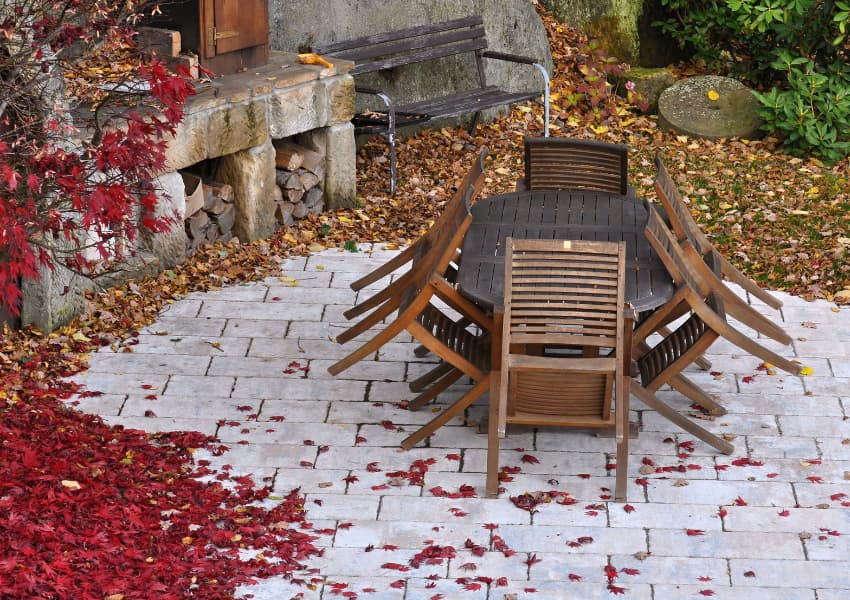As the vibrant hues of summer begin to fade, giving way to the rich and rustic tones of autumn, our gardens naturally transform. The cooler air, crisp mornings, and the evenings drawing in are signals for trees to shed their leaves and for homeowners to think differently about their outdoor spaces.
One integral aspect of this shift is the garden furniture we enjoyed during the balmy summer months (well, not this summer, at least). Just as we adjust our wardrobes in anticipation of the colder weather, our outdoor furniture, too, requires special attention. Preparing your garden furniture for autumn is about ensuring its longevity and preserving its aesthetics and function.

Why Autumn Maintenance?
Autumn presents specific challenges for garden furniture that necessitate proactive care:
- Autumn sees varying temperatures. This expansion and contraction from temperature changes can accelerate wear and tear on materials.
- The season can bring rain, dew, and early frost. Wood and metal can absorb moisture, leading to rot, rust, and mould issues.
- Falling leaves can trap moisture on furniture surfaces, potentially leading to stains and further moisture-related problems.
Regular maintenance ensures furniture lasts longer. Addressing the specific needs of your items in the autumn prepares them for winter and increases their lifespan overall.
Though it might require effort, seasonal care is cost-effective in the long run. Preventive measures can save you from expensive repairs or replacements down the line.
Cleaning Your Garden Furniture
Cleaning before the autumn season helps remove summer residues and prepare the furniture for the upcoming weather conditions.
- Use pH-neutral detergents for a gentle clean.
- A soft cloth or sponge for wiping surfaces.
- A stiff brush (non-metal) for stubborn spots.
Cleaning Based on Material:
Wood:
- Clean with a mild soapy solution to remove grime.
- Use specific wood cleaners for stubborn stains.
- Treat with a wood-specific sealant for protection.
Metal:
- Wipe down with a damp cloth.
- For signs of rust, use a rust remover and consider applying a protective sealant.
Rattan/Wicker:
- Vacuum gently to remove debris between weaves.
- Wipe with a damp cloth, using a mild detergent for stains.
- Dry thoroughly to prevent mould growth.
Plastic:
- Use soapy water for cleaning.
- A diluted bleach solution can help restore brightness for tougher stains.
Protecting Your Furniture from the Elements
Covers provide a primary shield against rain, dew, falling debris, and direct sunlight, preventing premature wear and damage.
Choosing the Right Covers:
- Opt for covers made from robust, weather-resistant materials.
- Ensure the cover fits snugly around your furniture, preventing unwanted moisture or debris from sneaking in.
- Look for covers with ventilation to prevent mould and mildew formation underneath.
Positioning Furniture for Protection:
- Prolonged direct sunlight can fade furniture. Place furniture in shaded areas during peak sunlight hours.
- Strong winds can topple lightweight items. Position furniture against walls or heavy planters to provide added stability.
- Avoid placing furniture in low-lying areas where water may pool.
Place furniture beneath overhangs, pergolas, or alcoves to provide added protection from the elements. Grouping furniture can also reduce exposure to wind and rain.
Storing Garden Furniture
Your storage choices might differ based on how much room you have, whether it’s a garage, shed, or under a covered patio.
Indoor Storage:
Provides the best protection against elements. Reduces the risk of moisture build-up, pests, and potential theft.
Outdoor Storage:
Convenient, mainly if you have limited indoor space or the furniture will be used intermittently.
Storage Tips:
Ensure furniture is dry before storing. Use desiccants or moisture absorbers if stored in enclosed spaces like sheds.
For outdoor storage, lift furniture off the ground using pallets or stands to reduce direct contact with wet surfaces.
Check cushions and furniture crevices for pests before storing.
Consider using natural repellents or cedar balls to deter pests in indoor storage areas.
Autumn Furniture FAQs
Q: How often should garden furniture be cleaned?
It’s recommended to thoroughly clean garden furniture at least twice a year: once after winter to prepare it for summer and once before autumn to protect it from winter elements. However, periodic spot cleaning throughout the year can help tackle stains and debris, ensuring the garden furniture always looks its best.
Q: Is it essential to cover all-weather furniture?
While all-weather furniture is designed to withstand various conditions, covering it can provide additional protection, prolonging its lifespan. Covers can shield furniture from excessive moisture, UV rays, falling debris, and pests. While it might not be essential, it’s a preventive measure that can be beneficial in the long run.
Q: What if I don’t have indoor storage options?
If indoor storage isn’t an option, consider the following:
- Use high-quality furniture covers that provide ventilation to prevent mildew.
- Elevate furniture off the ground using stands or pallets to prevent moisture absorption.
- Group furniture together and place it in sheltered areas of your garden, like beneath trees or against walls, to protect it from harsh winds and direct rain.
Q: How can I protect my furniture from pests during autumn?
Pests often seek shelter during the colder months, and your garden furniture might be an attractive spot. Here’s how you can deter them:
- Clean furniture thoroughly before storing or covering.
- Check cushions and any hidden crevices for pests regularly.
- Around storage areas, Use natural repellents, such as cedar balls or essential oils like eucalyptus or lavender.
Related Articles
- Protecting and Storing your Garden Furniture over Winter
- Maintenance Tips for Outdoor Aluminium Furniture
- Maintenance Tips for Outdoor Teak Furniture
- How to Clean Green Algae Off Garden Furniture
- Will Snow Damage Garden Furniture?